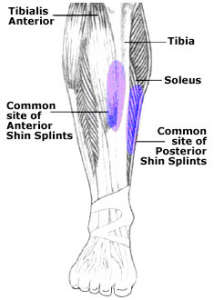Sport Rehabilitation and Physiotherapy for Shin Splints

What are Shin Splints?
There are two types of shin splints:
- Anterior Shin Splints – pain at the front of the shin bone (tibia).
- Posterior or Medial Shin Splints – pain on the inside of the shin bone (tibia).
This condition is also known as compartment syndrome as it results in a build-up of pressure within the differing compartments of muscles in the lower leg which are separated by sheaths of connective tissue.
What Causes Shin Splints?
The main cause is repetitive weight bearing activities coupled with pronation which is when the foot rolls too far inward. This creates a twisting strain on the shin muscles which causes pain, swelling and tears. In severe cases the muscle may start to tear away from the tibia causing stress fractures.
What are the Symptoms of Shin Splints?
Pain which usually begins as a dull ache after prolonged weight bearing activities. If left untreated, the pain becomes sharp and intense with all weight-bearing activities.
What will treatment consist of for Shin Splints?
Massage – Encompassing a variety of techniques with sufficient pressure through the superficial tissue to reach the deep lying structures. It is used to increase blood flow, decrease swelling, reduce muscle spasm and promote normal tissue repair.
Mobilisation – A manual technique where the joint and soft tissues are gently moved by the therapist to restore normal range, lubricate tissues and relieve pain.
Ultrasonic Therapy – Transmits sound waves through the tissues stimulating the body’s chemical reactions and healing process, just as shaking a test tube in the laboratory speeds up a chemical reaction. It reduces tissue spasm, accelerates healing and results in pain relief.
Interferential Therapy – Introduces a small electrical current into the tissues and can be used at varying frequencies for differing treatment effects. E.g. pain relief, muscle or nerve stimulation, promoting blood flow and reducing inflammation.
What other treatments could be used for Shin Splints?
Acupuncture – An oriental technique of inserting needles into the skin to increase or decrease energy flow to promote pain relief and healing.
Taping/Strapping – May be used if thought necessary to restrict abnormal movement and prevent further damage.
What can you do yourself to help Shin Splints?
Active Rest – Keep active but avoid aggravating activities particularly weight bearing activities such as running.
Apply an ice pack – For a maximum of 20 minutes. A bag of frozen peas wrapped in a damp cloth works well because it moulds to the shape of the tissues. Ensure that you do not apply ice directly to the skin as this can cause an ice burn.
Contrast bathing – From 5 days post injury apply a hot pack for 5 minutes followed by a cold pack for 5 minutes repeat for approximately 20 – 30 minutes.
Exercise programme – This is the most important part of the rehabilitation. Your therapist will instruct you as to which exercises to begin with, when to add the others, as well as how to progress the exercises.
Medication – Ask your GP or Pharmacist for advice on the best medication for your condition.
Podiatry – An analysis of the foot mechanics and structure during walking or running and correction as appropriate.
What if physical therapy does not help or resolve Shin Splints?
It is very rare that treatment does not resolve this condition, however in very extreme cases surgery is an option. This can be discussed with your therapist if appropriate.
If you think you may have this condition we would love the opportunity to show you our expertise in the treatment and management of this condition so – Please click here for details of how to contact us to book an appointment
If you are unsure whether you have this condition or you would just like to speak to somebody then please get in touch here or call 0161 745 7551 or 0151 515 2323.
